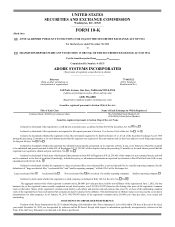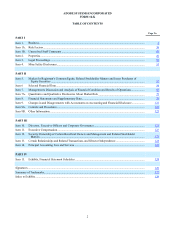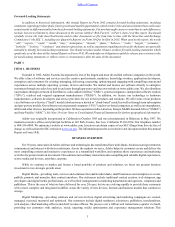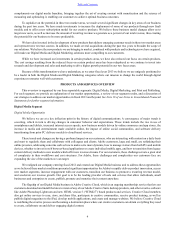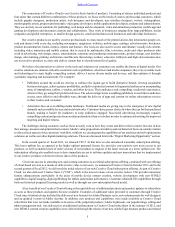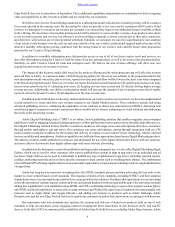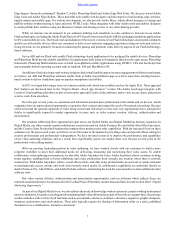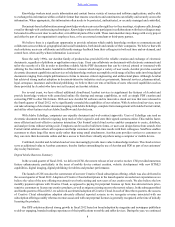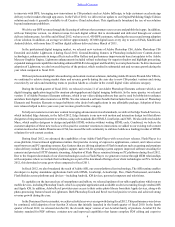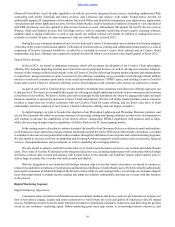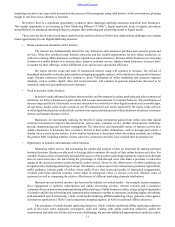Adobe 2012 Annual Report Download - page 8
Download and view the complete annual report
Please find page 8 of the 2012 Adobe annual report below. You can navigate through the pages in the report by either clicking on the pages listed below, or by using the keyword search tool below to find specific information within the annual report.
8
Knowledge workers must create information and content from a variety of sources and software applications, and be able
to exchange this information within a reliable format that ensures coworkers and constituents can reliably and securely access the
information. When appropriate, this information often needs to be protected, authenticated, or securely managed and controlled.
Document-based collaboration among knowledge workers can occur through face-to-face meetings, via phone calls, through
e-mail or through web conferencing technologies. Knowledge workers who participate in collaborations with their colleagues may
be located in offices next door to each other, or in different parts of the world. These team members may change with every project
and either be part of an organization's employee base, or be an external consultant or third-party partner.
We believe there is a significant opportunity to provide solutions which enable knowledge workers to communicate and
collaborate across technical, geographical and social boundaries, both inside and outside of their companies. We believe that with
such solutions, users can collaborate and efficiently manage feedback from their colleagues in both real time and on-demand, and
control how, when and by whom information is accessed.
Since the early 1990s, our Acrobat family of products has provided for the reliable creation and exchange of electronic
documents, regardless of platform or application source type. Users can collaborate on documents with electronic comments and
tailor the security of a file in order to distribute reliable Adobe PDF documents that can be viewed, printed or interacted with
utilizing the free Adobe Reader. Available in different versions which target a variety of user needs, Acrobat provides essential
electronic document capabilities and services to help knowledge workers accomplish a wide range of ad hoc tasks involving digital
documents ranging from simple publications to forms to mission critical engineering and architectural plans. Although Acrobat
has achieved strong market adoption in document-intensive industries such as government, financial services, pharmaceutical,
legal, aerospace, insurance and technical publishing, we believe there are tens of millions of users who need capabilities such as
those provided by Acrobat who have not yet licensed an Acrobat solution.
For several years, we have offered additional cloud-based Acrobat services to supplement the features of Acrobat and
provide knowledge workers with centralized online file sharing and storage capabilities, as well as simple PDF creation and
converting PDF to other file formats. With our new Acrobat XI software and its innovative cloud services that were released in
the fourth quarter of fiscal 2012, we've significantly extended the capabilities of our solution. With Acrobat cloud services, users
can take advantage of electronic document signing with Adobe EchoSign, complete form management with Adobe FormsCentral,
and utilize other features such as Adobe SendNow and Acrobat.com.
With Adobe EchoSign, companies can expedite document and web contract approvals. Users of EchoSign can send an
electronic document to others for signing, keep track of who's signed it, and store their signed contracts online. This enables faster,
more efficient and cost-effective customer interaction. Our FormsCentral cloud service enables companies to create, distribute,
and analyze forms without writing code. Templates can be used to build new forms, or users can design forms from scratch. Our
FormsCentral solution collects all responses and helps customers share real-time results with their colleagues. SendNow enables
customers to share large files more easily rather than using email attachments. Acrobat.com provides services to customers so
they can store their documents online and have access to them from virtually anywhere using a computer or mobile device.
Combined, Acrobat and Acrobat cloud services increasingly provide more value to knowledge workers. The cloud services
serve as additional value to Acrobat customers, thereby further entrenching the use of Acrobat and PDF as part of our customers'
day-to-day businesses.
Digital Media Business Summary
In the second quarter of fiscal 2012, we delivered CS6, the newest release of our creative toolset. CS6 provided numerous
feature enhancements, particularly in the areas of mobile device content creation, website development with new HTML5
capabilities, digital imaging, digital publishing for tablets and product performance.
The launch of CS6 was also the cornerstone of our new Creative Cloud subscription offering, which was also delivered in
the second quarter of fiscal 2012. Adoption of Creative Cloud subscriptions in the launch quarter exceeded our expectation as we
believe the value of the new offering was attractive to both existing and new users of our creative tools. We also believe the low
monthly payment options with Creative Cloud, as opposed to paying for perpetual licenses up front, has attracted more price-
sensitive customers to license our creative products, as well as migrate existing users to the newest release. In the subsequent third
and fourth quarters of fiscal 2012, we achieved accelerated adoption of Creative Cloud. In each of these three quarters, the success
of Creative Cloud subscription adoption adversely affected reported revenue as we recognize revenue associated with our
subscription offerings ratably whereas revenue associated with our perpetual licenses is generally recognized at the time of initially
licensing the products.
Our DPS solution achieved strong growth in fiscal 2012 based on broad adoption by magazine and newspaper publishers
to deliver engaging, branded reading experiences of their publications to mobile and tablet devices. During the year, we continued
Table of Contents

